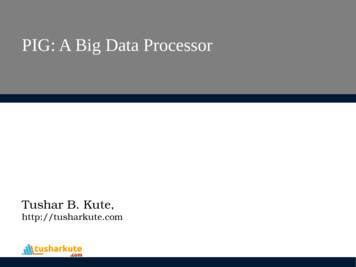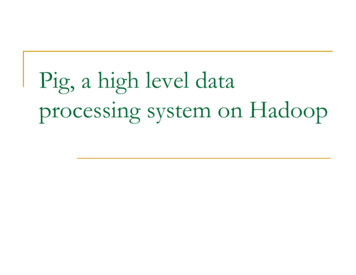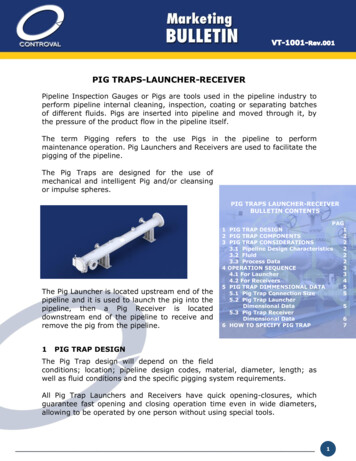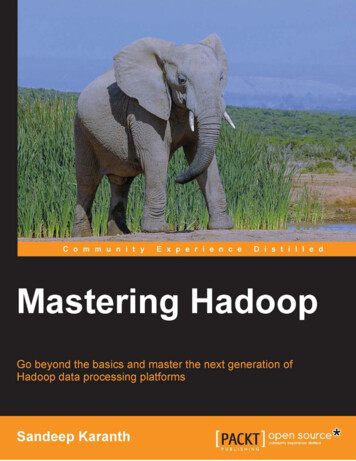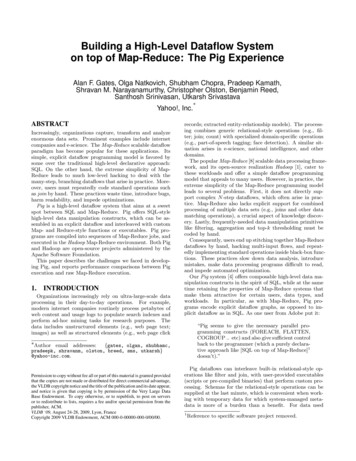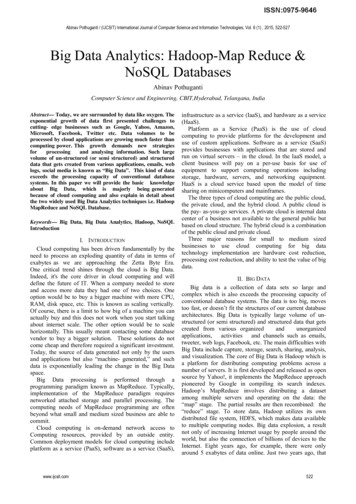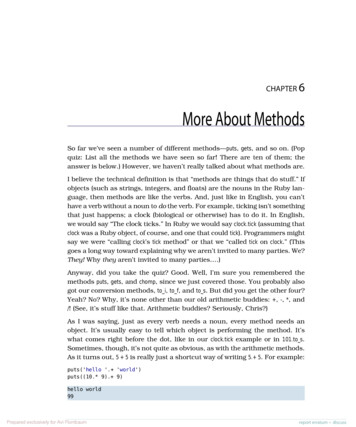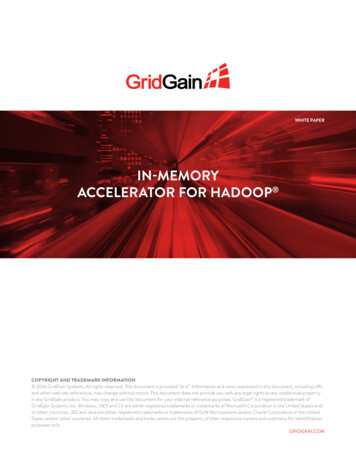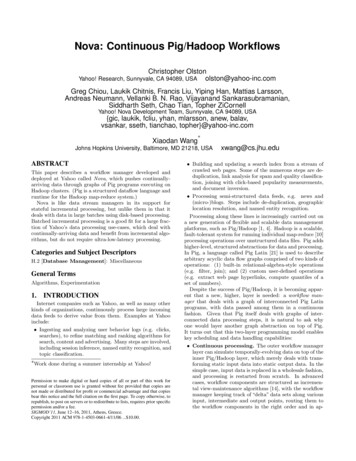
Transcription
Nova: Continuous Pig/Hadoop WorkflowsChristopher Olstonolston@yahoo-inc.comYahoo! Research, Sunnyvale, CA 94089, USAGreg Chiou, Laukik Chitnis, Francis Liu, Yiping Han, Mattias Larsson,Andreas Neumann, Vellanki B. N. Rao, Vijayanand Sankarasubramanian,Siddharth Seth, Chao Tian, Topher ZiCornellYahoo! Nova Development Team, Sunnyvale, CA 94089, USA{gic, laukik, fcliu, yhan, mlarsson, anew, balav,vsankar, sseth, tianchao, topher}@yahoo-inc.com Xiaodan WangJohns Hopkins University, Baltimore, MD 21218, USAABSTRACTThis paper describes a workflow manager developed anddeployed at Yahoo called Nova, which pushes continuallyarriving data through graphs of Pig programs executing onHadoop clusters. (Pig is a structured dataflow language andruntime for the Hadoop map-reduce system.)Nova is like data stream managers in its support forstateful incremental processing, but unlike them in that itdeals with data in large batches using disk-based processing.Batched incremental processing is a good fit for a large fraction of Yahoo’s data processing use-cases, which deal withcontinually-arriving data and benefit from incremental algorithms, but do not require ultra-low-latency processing.Categories and Subject DescriptorsH.2 [Database Management]: MiscellaneousGeneral TermsAlgorithms, Experimentation1.INTRODUCTIONInternet companies such as Yahoo, as well as many otherkinds of organizations, continuously process large incomingdata feeds to derive value from them. Examples at Yahooinclude: Ingesting and analyzing user behavior logs (e.g. clicks,searches), to refine matching and ranking algorithms forsearch, content and advertising. Many steps are involved,including session inference, named entity recognition, andtopic classification. Work done during a summer internship at Yahoo!Permission to make digital or hard copies of all or part of this work forpersonal or classroom use is granted without fee provided that copies arenot made or distributed for profit or commercial advantage and that copiesbear this notice and the full citation on the first page. To copy otherwise, torepublish, to post on servers or to redistribute to lists, requires prior specificpermission and/or a fee.SIGMOD’11, June 12–16, 2011, Athens, Greece.Copyright 2011 ACM 978-1-4503-0661-4/11/06 . 10.00.xwang@cs.jhu.edu Building and updating a search index from a stream ofcrawled web pages. Some of the numerous steps are deduplication, link analysis for spam and quality classification, joining with click-based popularity measurements,and document inversion. Processing semi-structured data feeds, e.g. news and(micro-)blogs. Steps include de-duplication, geographiclocation resolution, and named entity recognition.Processing along these lines is increasingly carried out ona new generation of flexible and scalable data managementplatforms, such as Pig/Hadoop [1, 4]. Hadoop is a scalable,fault-tolerant system for running individual map-reduce [10]processing operations over unstructured data files. Pig addshigher-level, structured abstractions for data and processing.In Pig, a language called Pig Latin [21] is used to describearbitrary acyclic data flow graphs comprised of two kinds ofoperations: (1) built-in relational-algebra-style operations(e.g. filter, join); and (2) custom user-defined operations(e.g. extract web page hyperlinks, compute quantiles of aset of numbers).Despite the success of Pig/Hadoop, it is becoming apparent that a new, higher, layer is needed: a workflow manager that deals with a graph of interconnected Pig Latinprograms, with data passed among them in a continuousfashion. Given that Pig itself deals with graphs of interconnected data processing steps, it is natural to ask whyone would layer another graph abstraction on top of Pig.It turns out that this two-layer programming model enableskey scheduling and data handling capabilities: Continuous processing. The outer workflow managerlayer can simulate temporally-evolving data on top of theinner Pig/Hadoop layer, which merely deals with transforming static input data into static output data. In thesimple case, input data is replaced in a wholesale fashion,and processing is restarted from scratch. In advancedcases, workflow components are structured as incremental view-maintenance algorithms [14], with the workflowmanager keeping track of “delta” data sets along variousinput, intermediate and output points, routing them tothe workflow components in the right order and in ap-
propriate batches, and folding them into base data setsas needed. Independent scheduling. Different portions of a workflow may be scheduled at different times/rates. For example, global link analysis algorithms may only be runoccasionally due to their costly nature and consumers’tolerance for staleness. On the other hand, the pathwaythat ingests new news articles, tags them with (somewhat stale) link analysis scores, and folds them into anindex for serving, needs to operate (almost) continuously.Other important capabilities that are a good fit for theworkflow layer include: Cross-module optimization. An overarching workflow manager can identify and exploit certain optimization opportunities. For example, given two workflowcomponents that consume a common input and wind upbeing scheduled around the same time, it can be beneficial to merge them dynamically to amortize the datareading cost. Other, more aggressive multi-query optimization [26] strategies can be employed, as well as automatic pipelining: connecting the output of one moduledirectly to the input of a subsequent module (subject toscheduling and fault-tolerance considerations), to avoidthe overhead of materializing the intermediate result inthe file system1 . Manageability features. It can help human operatorsmanage the workflow programming, execution and debugging lifecycle by keeping track of versions of workflowcomponents [11], capturing data provenance and makingit easily queriable [8], and emitting notifications of keyevents such as a workflow component finishing or failing.We have built a system at Yahoo called Nova that providesthese features, and is used in production. For practical reasons, Nova was designed as a layer on top of an unmodifiedPig/Hadoop software stack. We believe Nova is a good design given this constraint. It is likely that, given the abilityto modify the underlying Pig/Hadoop systems, one wouldfind more efficient designs, e.g. more efficient ways to manage state for continuous processing [17].1.1Related WorkData processing workflows have been studied extensivelyin the scientific workflow literature [18], including a recentproject that integrates Hadoop with a scientific workflowmanager [27]. In the Internet data processing space, motivated by some of the points listed above, several Hadoopbased workflow managers are starting to emerge (e.g. Cascading [22] and Oozie [3]). What sets Nova apart is its support for stateful continuous processing of evolving data sets.To avoid replicating basic workflow capabilities, Nova is layered on top of Oozie, which handles dependency-aware batchexecution of sets of workflow elements, automatic retry andfailure management, and many other core features.Non-workflow-based approaches to continuous processingin a map-reduce-like environment include [15, 17, 25]. Mapreduce-style systems cannot achieve the ultra-low latenciesrequired in some contexts; data stream management systems [12] are a better fit there. The recent MapReduce1A less invasive alternative is to lower the level of redundancy for intermediate files.Online system [9] is an attempt to unify the stream andmap-reduce paradigms.Google’s Percolator [24] performs transactional updates toBigTable [7] data sets, and uses triggers to cascade updatesin a manner similar to a workflow. Like data stream systems, Percolator targets applications that require updatesto be applied with very low latency, and so Percolator applies updates in an eager fashion (although under the covers,BigTable worker nodes buffer recent updates in memory).Nova, on the other hand, opts to accumulate many updatesand apply them in a lazy, batched (and non-transactional)fashion with the aim of optimizing throughput at the expense of latency. Also, Nova sits on top of Pig and hencere-uses the Pig Latin data processing abstraction.1.2OutlineThe remainder of this paper is structured as follows. Webegin by describing Nova’s abstract workflow model in Section 2, and then tie the model to Pig/Hadoop in Section 3.The architecture of the Nova workflow manager is describedin Section 4. Some performance measurements are reportedin Section 5. There are many avenues for future work, andwe list some of them at the end of the paper in Section 6.2.ABSTRACT WORKFLOW MODELA workflow is a directed graph with two kinds of vertices:tasks and channels. Tasks are processing steps. Channelsare data containers. Edges connect tasks to channels andchannels to tasks; no edge can go from a task to a task orfrom a channel to a channel.Figure 1 shows an example workflow, with tasks depictedas rectangles and channels depicted as cylinders. This workflow identifies unique news articles in an incoming RSS feed.The “template detection” task looks at all articles from thesame web site and identifies common template patterns,which are to be factored out of the de-duplication process(i.e. two news articles are considered duplicates if they havedifferent template content but the same “main content”).“Template tagging” tags the portion of each article that isthought to be a template, according to the site templatesoutput by “template detection.” “Shingling” applies a hashdigest technique used extensively for de-duplication in theweb domain, called shingling [6], to the non-template content of each article. Finally, the “de-duping” task compareseach incoming article’s shingle hash against the hashes thathave been seen previously; if the article’s hash is new thearticle is sent to the output (and the hash is stored in the“shingle hashes seen” channel for future reference); otherwisethe article is discarded.The behavior of each task, in terms of how new inputdata is folded into the computation, is dictated by the edgeannotations (all, new, B and ), which are called consumption and production modes. Informally speaking, allreads a complete snapshot of the data from a given inputchannel; new only reads data that is new since the last invocation; B emits a new, full snapshot to a given outputchannel; and emits new data that augments any existing data. The workflow in Figure 1 illustrates four commonpatterns of processing: Non-incremental (e.g. template detection). Processinput data from scratch every time.
Figure 1: Example workflow. Stateless incremental (e.g. shingling). Process justthe new input data; each data item is handled independently, without reference to any state. Stateless incremental with lookup table (e.g. template tagging). Process just the new input data independently of prior input data items; a side “lookup table”may be referenced. Stateful incremental (e.g. de-duping). Process justthe new input data, but maintain and reference somestate about prior data seen on that input.Sections 2.1 and 2.2 are dedicated to explaining the datamodel and task consumption/production modes in detail.The rest of Section 2 discusses task scheduling policies, andsome important space and time optimizations.2.1Data and Update ModelA channel’s data is divided into blocks, each of which contains a set of data records or record transformations thathave been generated by a single task invocation. Blocksmay vary in size from kilobytes to terabytes. For the purpose of workflow management, a block is an atomic unit ofdata. Blocks also constitute atomic units of processing: atask invocation consumes zero or more input blocks and processes them in their entirety; partial processing of blocks isnot permitted.Data blocks are immutable, and so as channels accumulatedata blocks their space footprint can grow without bound.This situation is addressed by special compaction and garbagecollection operations, described in Section 2.4.There are two types of blocks: base blocks and delta blocks(bases and deltas, for short). A base block contains a complete snapshot of data on a channel as of some point in time.Base blocks are assigned increasing sequence numbers, andare denoted B1 , B2 , . . . , Bn . Every channel is seeded withan initial, empty base block B0 .Delta blocks are used in conjunction with incremental processing. A delta block contains instructions for transforminga base block into a new base block, e.g. by adding, updating or deleting records or columns. A delta block thattransforms base Bi into base Bj (where i j) is denoted i j .The process of applying a delta block to a base block,to form a new base block, is called merging, writtenM (Bi , i j ) Bj . The reverse transformation, wherebytwo base blocks are compared to create a delta block thattransforms one to the other, is called diffing: D(Bi , Bj ) i j . Lastly, a chain function C(·) is used to combine multiple delta blocks: C( i j , j k ) i k . A commonpattern is for merging and chaining to be used together, tocombine a base block with a sequence of delta blocks, as inM (Bi , C( i j , C( j k , k l ))) Bl .Each channel has associated merge, chain and diff functions. These functions may vary from channel to channel,depending on the type of data and data updates each channel supports. A common and simple situation is for a channel to support only appending of records, in which case themerge and chain functions are both bag union (typicallyachieved via simple file concatenation) and the diff function is bag difference. (Our example workflow in Figure 1requires only append-based channels.) However Nova supports general merge, chain and diff functions, as long as theyadhere to some basic rules: The chain function is requiredto be associative, merge and diff must be inverses, and thefollowing relationship must hold between merge and chain:M (M (Bi , i j ), j k )) M (Bi , C( i j , j k )) Bk .Aside from append-only data, perhaps the most commonscenario is the upsert model, which leverages the presenceof a primary key attribute to encode updates and inserts ina uniform way. With upserts, delta blocks are comprisedof records to be inserted, with each one displacing any preexisting record with the same key. Upserts are convenientin many situations, e.g. a crawler might emit upserts consisting of (url, content) pairs, which eliminates the need forthe crawler to remember whether a particular URL is beingvisited for the first time or revisited, because in the lattercase the new content snapshot automatically supersedes theold one in the output channel. The upsert merge and chainfunctions perform co-group [21] on the key attribute, andretain only the most recent record with a given key. Thediff function performs a set difference.2.2Task/Data InterfaceA task must declare, for each incoming edge from a datachannel, its consumption mode: one of all or new2 . Con2To support incremental join algorithms, Nova also offers aspecial old mode, which can only be used in conjunctionwith a new-mode connection to the same input channel.old yields a complete snapshot as of the point reached bythe new-mode connection in the previous invocation.
sumption mode all denotes that each time the task is executed, it is fed a complete snapshot of the data residing onthe input channel in the form of a base block. If the channelcontains a base block followed by one or more deltas, thelatest base snapshot is created automatically on the fly viaapplication of the merge and chain functions. This processis transparent to the task. In our example workflow in Figure 1, whenever the “template detection” task is invoked thesystem merges all accumulated deltas from the RSS feed toform a single, latest, base block to feed into template detection.Consumption mode new denotes that each task executionis to be fed just new data that has not been seen in priorinvocations, in the form of a delta block i j , where i is thehighest sequence number read in the most recent successfulexecution and j is the highest sequence number available onthe channel. If it does not exist explicitly, the block i jcan be created on the fly using the diff or chain function, asneeded. For each task input that uses consumption modenew, Nova maintains an input position cursor, in the formof the highest read sequence number. (To handle cases inwhich i j, Nova keeps a special zero-byte file to feed totasks as an empty delta block.3 ) In our example workflow(Figure 1), if “shingling” is invoked less often than “templatetagging,” then multiple template tagging output delta blockswill be chained into a single delta block to feed into shingling.Tasks must also declare a production mode for each outgoing edge to a channel—either B or —to indicate the typeof block the task emits to that channel. In our example, eachinvocation of “template detection” emits a new base blockthat replaces any prior data in the “news site templates”channel. In contrast, each invocation of “de-duping” merelyemits a delta block that augments prior data in the “uniquearticles” output channel.2.3Workflow Programming and SchedulingWorkflows are programmed bottom-up, starting with individual task definitions, and then composing them into workflow fragments called workflowettes. Workflowettes are abstract processing components that are not attached to specific named data channels—instead they have ports to whichinput and output channels may be connected. Channelsare defined via a separate registration process from workflowettes. Once workflowettes and channels have been registered, a third process, called binding, attaches channels tothe input and output ports of a workflowette, resulting in abound workflowette.The last step is for the user to communicate scheduling requirements, by associating one or more triggers with a boundworkflowette. There are three basic types of triggers: Data-based triggers. Execute whenever new data arrives on a particular channel (typically a channel boundto one of the workflowette’s input ports). Time-based triggers. Execute periodically, every ttime units. Cascade triggers. Execute whenever the execution ofanother bound workflowette reaches a certain status (e.g.launched, completed successfully, failed).3It is not always valid to cancel execution of a task whenthere is no new data on one of its inputs, e.g. consider atask that performs set difference.Once triggered, execution of a bound workflowette is atomic,i.e. any results of executions that fail mid-way are erasedand never become visible to users or other workflowettes.Our example news de-duplication workflow (Figure 1)might be implemented as two bound workflowettes: (1)template detection; (2) template tagging, shingling and deduping. A weekly time-based trigger might suffice for refreshing the site templates (first workflowette), whereas thetagging-shingling-de-duping pipeline (second workflowette)would likely use data-based triggers so that new news article batches are processed quickly.Nova also permits compound triggers, which combine twoor more triggers of the above types. A compound triggerfires once all of its constituent triggers have fired. And ofcourse, a user can always manually request to execute aparticular bound workflowette.Notice that the notion of a “full workflow” is not explicitlycaptured here. In Nova, a workflow is a behavior producedby a collection of bound workflowettes that exchange datavia shared channels and coordinate their execution via databased or cascading triggers.2.4Data Compaction and Garbage CollectionNova performs an important data representation optimization called compaction, which memoizes the result ofa merge (and chain) operation. For example, if a channelhas blocks B0 , 0 1 , 1 2 , 2 3 , the compaction operation computes and adds B3 to the channel.Another operation, garbage collection, removes unneededblocks. In our example, after compaction is used to addB3 to the channel, the old blocks B0 , 0 1 , 1 2 , and 2 3 may become eligible for garbage collection. Of course,garbage collection is constrained by the cursors of tasks thatconsume from the channel in new mode (see Section 2.2).For example if a consumer has a cursor at sequence number2 then only B0 , 0 1 , and 1 2 can be garbage-collected; 2 3 must be retained until the cursor advances. Nova alsosupports provenance querying (not discussed in this paper),which places additional constraints on garbage collection.Compaction, coupled with garbage collection, has two potential benefits: (1) if delta blocks contain updates and/ordeletions, then the compacted data may take up less spacethan the non-compacted representation; (2) all-mode consumers do not have to merge (as many) delta blocks on thefly. In the current Nova implementation, compaction andgarbage collection are triggered manually. We are workingon automated techniques to determine the best time to perform these operations, in view of optimizing certain spaceand/or time costs.3.TYING THE MODEL TO PIG/HADOOPAs mentioned earlier, Nova implements the data and computation model described in Section 2 on top of Pig/Hadoop.The content of each data block resides in an HDFS4 file (orperhaps a directory of “part” files, which is the unit of dataoutput by a Hadoop map-reduce job). Nova maintains themapping from data blocks to HDFS files/directories in itsmetadata (see Section 4). HDFS file names are hidden fromusers, and Nova generates unique file names by incrementinga global counter, e.g. /nova/block 0, /nova/block 1, etc.The notion of a channel exists solely in Nova’s metadata.4HDFS is the Hadoop filesystem.
Each task in a workflowette is specified by a Pig Latinprogram with open parameters for its input and output datasets, denoted by strings beginning with . For example, thePig Latin code for the “template tagging” task in our newsde-duplciation workflow (Figure 1) might look like this:register news processing udfs.jar;articles RAW ARTICLES;templates TEMPLATES;joined join articles by site, templates by site;tagged foreach joined generate TagTemplates(*);store tagged into TAGGED ARTICLES;where TagTemplates() is a user-defined function whose coderesides in the JAR file imported in the first line.Each time Nova invokes a task it binds to the task input and output parameters dynamically-constructed PigLatin expressions. In our example, suppose the latest baseblock for “news site templates” is stored in HDFS location /nova/block 25, and there are two delta blocks inthe append-based “news articles” channel that have not yetbeen sent through the template tagging task, stored at/nova/block 31 and /nova/block 32. If execution of thetagging task is triggered, its parameters will be bound asfollows: RAW ARTICLES union (load ‘/nova/block 31’),(load ‘/nova/block 32’); TEMPLATES load ‘/nova/block 25’; TAGGED ARTICLES ‘/nova/block 33’,where /nova/block 33 is a placeholder for the output blockthat the task execution will produce.As we saw in the above example, for append-based channels Nova implements delta block chaining via Pig Latin’sunion operator. In general, Nova supplies a set of templatesfor specifying each channel’s merge, chain and diff functions.Currently Nova supports two templates for merge and chainfunctions: (1) union all n input blocks; (2) cogroup the ninput blocks by a given key attribute k, and then apply agiven user-defined function f that performs a per-key mergeoperation (k and f are parameters to the template). For upserts, k is the channel’s primary key attribute and f choosesthe record residing in the right-most non-empty bag fromamong the n bags created by cogroup. The diff templatesfor append and upsert follow a similar pattern.As mentioned in Section 1.1, Nova relies on a system calledOozie [3] to execute DAGs of Pig Latin scripts, includingsome important details such as sandboxing the Pig clientcode, automatically re-trying failed scripts, and capturingand reporting status and error messages. Nova executes abound workflowette by first associating Pig Latin expressions with each input and output parameter of each of theworkflowette’s tasks (as described above), and then sending the resulting DAG of parameter-free Pig Latin scripts toOozie for execution and monitoring. Oozie reports the finalstatus (success or error) back to Nova. If the bound workflowette execution results in an error, Nova erases any outputblocks generated during its execution, to achieve atomicity.3.1File Formats and SchemasAn important detail we have glossed over is how file formats and schemas are handled. Pig does not have a systemcatalog, and it expects5 file formats and schemas to be specified in load statements, either via an explicit in-line schemadescription or via a special “load function” that reads somecatalog or self-describing data file and passes the schema information to Pig. Zebra [5] is a self-describing format thatcomes with such a Pig load function.Nova supports both manual and Zebra-based file format and schema specification. In the manual case, theuser must annotate each task’s output parameter (e.g. TAGGED ARTICLES) with a file format and schema. Novakeeps track of each block’s file format and schema in itsmetadata, and passes this information to downstream Pigtasks in the generated load expressions.In principle, this mechanism facilitates schema (and fileformat) evolution, whereby a new version of a task can emita different schema than an old version, resulting in blockswith different schemas on the same output channel. A downstream task would be fed the correct schema for each block.Nova also allows the merge, chain and diff functions to bespecified at a per-block granularity (versus per-channel), sothat task upgrades have the opportunity to adjust thesefunctions to accommodate the new schema and handle theboundary case of comparing blocks with different schemas.Unfortunately, Nova does not currently have support forautomatically synchronizing task upgrades. For example,suppose task X is upgraded so that new output blocks contain an extra column, and we wish to upgrade a downstreamtask Y so that it handles the new column. Currently there isno automated way to ensure that the switch to the new version of Y occurs when the first new X output block reachesY. Instead, at present users must synchronize the upgradesof X and Y using an onerous manual process that disruptstask scheduling, e.g. (1) de-register all triggers for X and Y;(2) manually trigger Y to clear out any old blocks betweenX and Y; (3) upgrade X and Y; (4) re-register the X and Ytriggers.4.WORKFLOW MANAGERARCHITECTUREFigure 2 shows the basic architecture of the Nova workflow manager, which is divided into several modules. Forthe most part, these modules represent software layers, notindependent threads. (The trigger manager module does,however, run in a separate thread so that it can supporttime-based events.)Most of Nova’s modules are part of a Nova server instanceprocess. The modules in a server instance are stateless;they keep their state externally, in a metadata database (currently, MySQL Cluster [23]). The metadata database can beshared among multiple Nova server instances, which run concurrently with no explicit synchronization (the state in themetadata database effectively synchronizes them). Clientrequests are load-balanced among the server instances; anyload-balancing policy can be used—currently we use a simple round-robin policy. A special watchdog module, managed via ZooKeeper [16] leader election, detects unresponsive server instances, kills them, starts fresh replacements,and reconfigures the load balancer’s routing table as needed.Nova supports two types of clients. Human clients haveaccess to a command-line interface and a web interface.5Pig can also be used without schemas, using positional notation to refer to fields.
When the workflowette execution finishes, the processmanager fills in or cancels the reserved output blocks(depending on whether the execution succeeded). Process optimizer: This is a placeholder for various performance optimizations on workflowette execution. Onetype of optimization has been implemented so far: merging pairs of workflowette executions that read the sameinput data and run around the same time, to amortizethe data reading cost (see Section 4.2). Other typesof optimizations we may consider in the future include:pipelining workflowettes that form a “chain,” and adjusting the degree of parallelism to trade resource consumption against execution time.Figure 2: Nova system architecture.Web-service clients interact with Nova via a SOAP webservices API. At Yahoo, Nova is deployed as part of a largersoftware environment that includes systems for data onboarding, data storage and processing (Nova), and data serving. The onboarding and serving systems interact with Novausing web services.The core Nova server modules are: User interface: This module provides API methodsfor registering (and deregistering) channels and workflowettes,6 and for binding workflowettes to channels toproduce bound workflowettes. Other key methods support registration/deregistration of triggers, insertion ofnew blocks into a channel (e.g. from the data onboardingsystem), monitoring workflowette execution status, andof course viewing the registered channels, workflowettes,bound workflowettes and triggers. Process manager: This module keeps track of registeredworkflowettes and bound workflowettes. It also respondsto trigger firing events by creating an executable instanceof the bound workflowette that was triggered (with thehelp of the data manager), and handing it off to theprocess executor to be run and have its execution statustracked. Data manager: The data manager maintains a list ofblocks associated with each cha
Pig/Hadoop software stack. We believe Nova is a good de-sign given this constraint. It is likely that, given the ability to modify the underlying Pig/Hadoop systems, one would nd more e cient designs, e.g. more e cient ways to man-age state for continuous processing [17]. 1.1 Related Work Data processing work ows have been studied extensively
